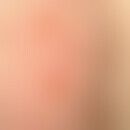Synonym(s)
DefinitionThis section has been translated automatically.
Frequent, primarily irritant, macerative-erosive dermatitis in the diaper area in infants (increasingly observed in demented and/or incontinent adults), caused by intensive and prolonged contact of the skin with excrements.
Occurrence/EpidemiologyThis section has been translated automatically.
Type I: One of the most common skin diseases of infancy. 7-35% of all infants develop diaper dermatitis one or more times at some time. About 6% of children develop severe diaper dermatitis with a tendency to secondary infections with Candica albicans and Staphylococcus aureus. Only 35% of children do not develop diaper dermatitis by 20 months of age.
Type II: Common skin disease in bedridden patients who permanently need diaper utensils for fecal and urinary incontinence.
You might also be interested in
EtiopathogenesisThis section has been translated automatically.
Occurs in otherwise healthy children and in adults in need of care due to the cumulative effect of various irritant factors that may affect the occluded skin diaper area (criteria of classical toxic contact dermatitis):
- Prolonged contact time of stool and urine
- Diarrhoeal diseases
- Change of diet to foods containing fruit acids (apple juice, orange juice, etc.)
- Probably also damage to the skin by trypsin and lipase in the stool (activity of the enzymes increases with increasing alkalisation) Stool from breastfed children is more acidic than that from those fed on cow's milk and is alkalised by ammonia.
- Friction and occlusion are prerequisites for dermatitis (maceration of the horny layer, warm and humid environment).
- Frequently secondary colonization by Candida species (see also under Candidoses)
ManifestationThis section has been translated automatically.
Type I: 9 to 12 months of age.
Type II: 70 - 90 years (if in need of care)
LocalizationThis section has been translated automatically.
ClinicThis section has been translated automatically.
Blurred, flat redness with blisters, erosions, scaling, rough, vegetating papules, scaly, spotty erosions and weeping areas. Signs of erosive maceration.
In case of very pronounced infestation (rather rare) formation of extensive ulcers (Jaquet's ulcers).
In case of superinfection by Candida species, erythema is limited by raised scaly margins interspersed with pustules. Often also smaller, disseminated, scaly erythema in the healthy environment (satellite lesions).
Differential diagnosisThis section has been translated automatically.
Eczema, atopic: Infantile atopic eczema can affect the diaper region, but this is rather the exception! This form of eczema often shows trunk- and head-emphasized weeping, crusty, very itchy, blurred erythema and eczema, which exactly leave out the diaper region (Note: as the diaper region remains continuously covered by Pampers, the atopic "vicious circle of itching and scratching" is interrupted in this area.
Nappy smell: an important distinguishing feature is the absence of deep skin folds (W-shape) in napkin dermatitis, whereas these areas are typically affected in candidiasis.
Infantile psoriasis vulgaris: it is often not "typical of adults". The pattern and distribution of the plaques are indicative. There are scaly plaques of varying size, inflammatory redness, sharp or blurred boundaries, also erythema, of varying size and configuration. Affected are the trunk, the extensor extremities, the seborrhoeic zones of the face and the capillitium. The diaper region is affected rather incidentally.
Seborrhoeic eczema of the infant(s.a. Eccema infantum): The diaper regions are rather slightly affected, if then in the groin region. Remarkably, the infants have little or no impairment (little or no itching). Eccema infantum is a rather self-limited form of eczema which occurs mainly in the first 3 months of life. There are red spots, papules or confluent plaques of varying intensity, usually localised, sharply defined, red spots. The trunk is mainly affected, here the seborrhoeic zones (sweat ducts in the sternal area, along the spine, shoulder girdle). Preferably, the skin folds are also affected in a bright red colour and without scales (scales are rubbed off there). Furthermore, dandruff is also found centrofacially, in the eyebrows and on the hairy scalp (in this case it is also found over a large area).
Contact eczema, allergic: Contact allergens are extremely rare triggers of "diaper dermatitis".
Streptococcal dermatitis, perianal: Rarely feverish picture. Usually non-infiltrated or only slightly infiltrated, easily delimited, perianal erythema of 0.5-3 cm Ø or papules which occasionally secrete pus. Strong, persistent itching and defecation pain. Bloody stool deposits in 30-40% of cases. There is often association with impetigo in other parts of the body. Diagnosis: Clinical, smear and bacterial culture. The diagnosis is often missed; in children it takes 1-12 months on average until the diagnosis is made.
Tinea glutealis (rather rare in infants): The picture is the typical picture of dermatophyte infection with itching and borderline scaly erythema and plaques. Native examination and culture are diagnostic.
Zinc deficiency, acquired or congenital (see below Acrodermatitis enteropathica): Symmetrical scaling and weeping erythema and plaques on the acromias and orifices (mouth, nose, anogenital region). Furthermore, recurrent diarrhoea, reduced general condition with growth disturbances, recurrent superinfections with yeasts (culture) must be considered. In the hereditary form, the initial manifestation of the disease occurs in infancy, usually after weaning; in the secondary forms of the disease, it occurs weeks, months or years after the onset of the underlying disease causing the zinc deficiency.
Granuloma gluteale infantum: Round, also oval, calotte-like or pad-like, blue-red to brown-red, bulging elastic nodes along the cleavage lines of the skin. Yellow-brown, lupoid discoloration under glass spatula pressure.
Rather rare DD are (according to Fölster-Holst) the Kawasaki syndrome, Langerhans cell histiocytosis and herpetic or HP virus diseases.
Complication(s)(associated diseasesThis section has been translated automatically.
TherapyThis section has been translated automatically.
For small children: In the warm season, leave children without nappies for a few hours. Underneath diaper dermatitis heals fastest!
Cleaning: Just use clear water or oil wipes (if the commercial cleaning wipes are not tolerated, the easiest way is to moisten paper towels with olive oil and thus gently clean the area). Alternatively sitz baths with bran bath (e.g. potter bran bath), if necessary use of synthetic tanning agents (e.g. Tannolact, Tannosynt).
Good drying of the region, warm blow-drying.
Nurturing and protecting hydrophilic zinc ointments: Hydrophilic anionic cream zinc pastes (O/W creams), e.g. R190 R193, are most suitable.
Note! Only hydrophilic bases are able to absorb liquids in sufficient quantities, therefore do not use lipophilic ointment bases.
Change diapers frequently (every 3-4 hours). Use modern diapers with gel pads.
Exclusion of mycotic or bacterial secondary colonisation or candidosis (microbiological smear, contact for shoots locally and in the oral cavity, if necessary examine stool for shoots, also in the mother).
In case of secondary candidosis: Apply antimycotic external agents (e.g. Multilind Paste, Candio Hermal Softpaste, R172) 2-5 times/day in a thin layer.
In severe erosive weeping conditions, possibly short-term combined therapy with hydrocortisone in soft pastes (e.g. Nystaderm comp®) should be applied thinly 2-3 times/day. S.a. Executions for granuloma glutaeale infantum.
In adults, a combined glucocorticoid/broadband antifungal preparation can also be used for a short time in the case of severe irritation (e.g. Vobaderm®= fluprednide/miconazole).
In a double-blind, placebo-controlled study, the efficacy of 0.25% miconazole nitrate in a zinc-containing base was demonstrated.
Notice! Due to the high risk of absorption fluorinated glucocorticoids are contraindicated! Due to the large-area inflammation, the absorption of local therapeutics can be up to 20 times higher!
- In case of enteral candidiasis: treatment of the oral cavity and rehabilitation of the intestine with a suspension or drops containing Nystatin(e.g. Moronal Suspension, Nystatin Lederle drops). Candidosis of the oral mucosa: drip 0.5-1.0 ml into the mouth 4-6 times/day after meals.
- Alternatively Amphotericin B suspension:
- KG < 1500 g: 4 times/day 0.2 ml p.o.
- KG > 1500 g: 4 times/day 0.4 ml p.o.
- Intestinal thrush: 4 times/day 1.0-2.0 ml before meals over 2 weeks. Furthermore, dragées or tablets (e.g. Mykundex mono Drg.) over 7-14 days. Examination and treatment of the mother is necessary.
Notice! Moronal Suspension is not used for premature babies due to the high osmolarity!
General therapyThis section has been translated automatically.
In English, the therapeutic measures are summarized under the acronym "ABCDE". Here it says:
- A = air - removal of occlusion. Children who do not wear diapers do not get diaper dermatitis.
- B = barriers - regeneration of the skin barrier.
- C = Cleansings - shortening the intervals between diaper changes (change intervals every 3-4 hours).
- D = Diapers - Modern diapers with gel pads transport the secreted liquid away from the skin. They provide a degree of dryness that cannot be achieved by cloth diapers.
- E = Education - Educating parents about the pathogenetic relationships.
ProphylaxisThis section has been translated automatically.
Lipophilic pastes are always indicated when the protection of a largely intact skin against aggressive body fluids or externals is required! Application e.g. during diaper change:
- Apply lipophilic pastes (Pasta zinci R191 thinly in the area of the diaper region when changing diapers (lipophilic pastes have a water-repellent effect). Cleaning with olive oil.
- Alternative: Lipophilic pastes/creams with an addition of olive oil (e.g. Pasta zinci mollis with olive oil).
- Linola Breathable Protective Balm
LiteratureThis section has been translated automatically.
- Arnold-Long M et al (2018) Incontinence-Associated Dermatitis and Intertriginous Dermatitis as Nurse-Sensitive Quality Indicators: A Delphi Study.J Wound Ostomy Continence Nurs 45:221-226.
- Cohen B (2017) Differential Diagnosis of Diaper Dermatitis. Clin Pediatr (Phila) 56(5_suppl):16S-22S.
- Concannon P et al (2001) Diaper dermatitis: a therapeutic dilemma. Results of a double-blind placebo controlled trial of miconazole nitrates 0.25%. Pediatric dermatol 18: 149-155
- Fölster-Holst (2011) Diaper dermatitis. dermatologist 62: 699-709
- Gupta A et al (2004) Seborrheic dermatitis. J Eur Acad Dermatol Venereol 18: 13-26
- Koch R (1991) Phytosterols in diaper dermatitis. Dt Dermatol 39: 1454-1459
- Prasad HR et al (2003) Diaper dermatitis--an overview. Indian J Pediatr 70: 635-637
- Seebacher C et al (2006) Candidosis of the skin. J Dtsch Dermatol Ges 4: 591-596
Incoming links (20)
Calendulae flos; Cod liver oil; Dermatitis ammoniacalis; Dermatitis glutealis infantum; Erythema glutaeale; Erythema neonatorum; Erythema papulosum posterosivum; Granuloma gluteale infantum; Napkin psoriasis; Newborns, skin changes; ... Show allOutgoing links (29)
Acrodermatitis enteropathica; Atopic dermatitis in infancy; Atopic dermatitis (overview); Bubble; Candida; Candidiasis of the oral mucosa; Candidoses; Candidosis, enteral; Contact dermatitis toxic; Dermatitis; ... Show allDisclaimer
Please ask your physician for a reliable diagnosis. This website is only meant as a reference.






